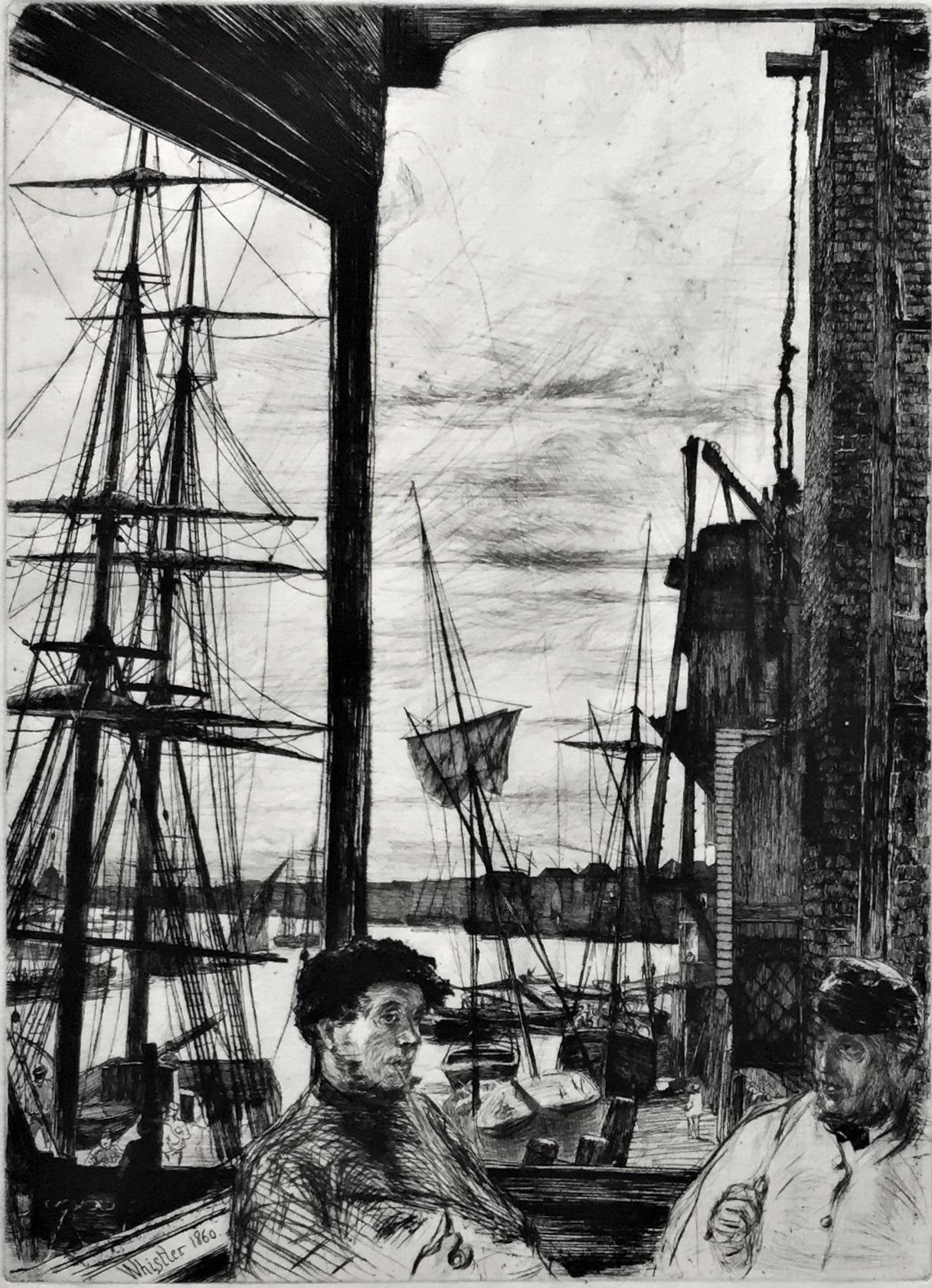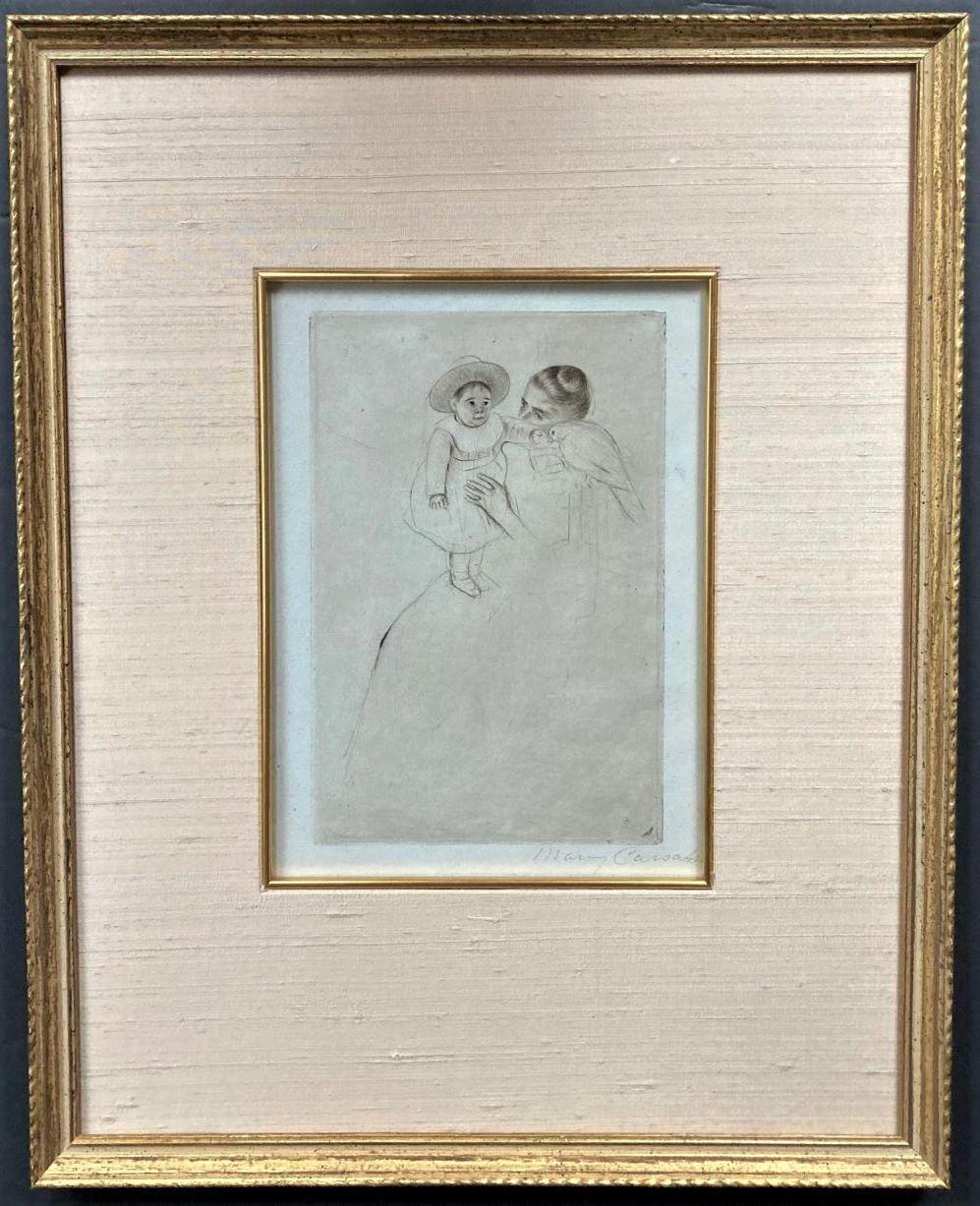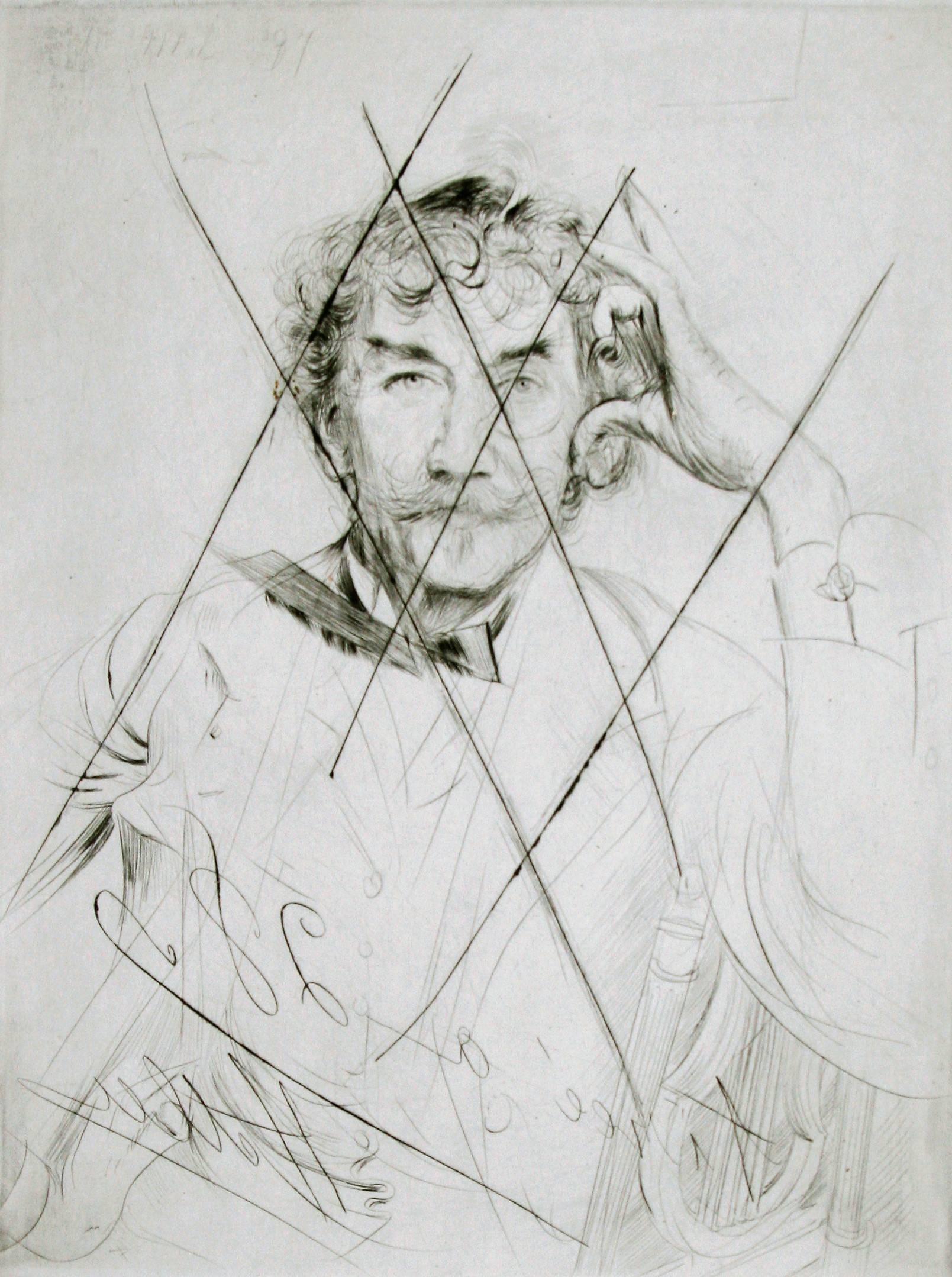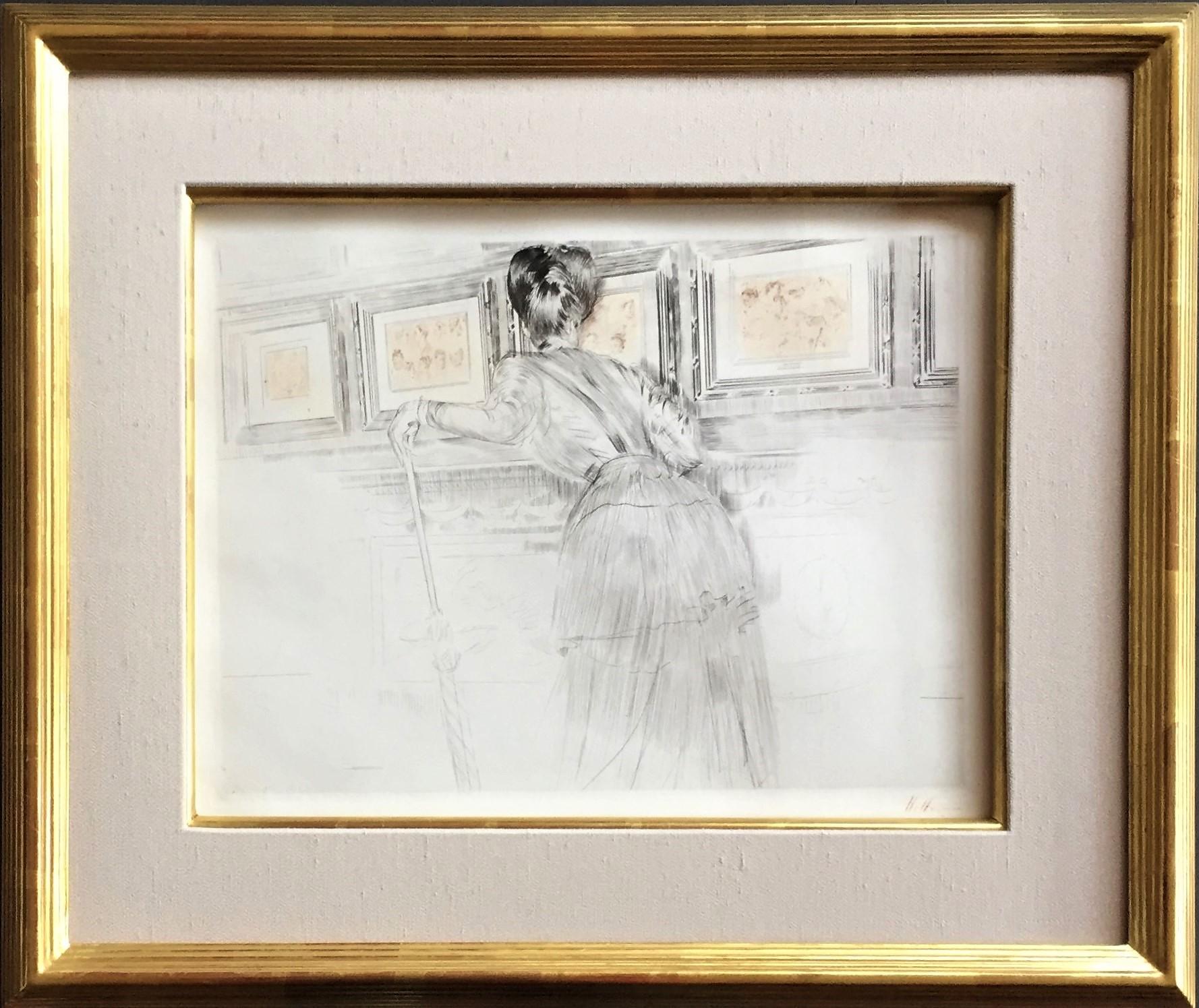Articles similaires à Dans les Cendres (In the embers)
Vous voulez plus d'images ou de vidéos ?
Demander au vendeur plus d'images ou de vidéos
1 sur 8
Albert BesnardDans les Cendres (In the embers)1887
1887
À propos de cet article
Dans les Cendres (In the embers). 1887. Delteil catalog 67 state iii. State after the plate was cut down and a second figure eliminated (the two earlier states are of the greatest rarity). Etching, drypoint and roulette. 16 3/4 x 12 1/8 (sheet 19 1/2 x 14). Edition 50. Illustrated: Print Collector's Quarterly 9 (1921): 254. A very rich impression with plate tone and drypoint burr, printed on simili-japon. Provenance: Frederick Keppel & Co. This is one of the artist's most striking images. Signé au crayon. Housed in 25 x 20-inch archival mat, suitable for framing.
Paul Albert Besnard, was an impressionist painter. In 1866, the seventeen-year-old son of artist parents began his studies at the École des Beaux-Arts Paris. In 1874, Besnard won the important Prix de Rome, with which the academy distinguished young talent. A portion of the scholarship is a stay of several years in Rome. Besnard married Charlotte Dubray, a sculptress, during this time in Rome. The couple lived in England, where Besnard exhibited at the Royal Academy London, between 1881 and 1884. He became involved with English portrait painting during this period, which had a lasting influence on his work.
In the years that followed, Besnard broke with the academic tradition. In 1886, he presented the portrait of Madame Roger Jourdain at the Paris Salon, which showed his new characteristic style: Inspired by the contemporary group of impressionists of this time, Besnard attempted to capture light and color in his works. However, the artist was not an impressionist in the actual sense; he adopted the technique for the precise analysis of lighting, but did not entirely share in the impressionist interest in the realistic reproduction of impressions.
Besnard was a master of his trade and had a good command of painting in watercolors, pastels, and oil, as well as etching. He found his motifs both in portrait painting and in landscape painting. Besnard also decorated numerous Parisian buildings, including the ceiling of the Comédie Française and the dome of the Petit Palais.
In 1913, Besnard was appointed to be the director of Villa Medici in Rome; in 1922, he became the director of the Ecole des Beaux-Arts. In 1924, he became the first painter since 1760 to be elected as a member of the Académie Française, one of the oldest and most prestigious institutions of the French intellectual world.
- Créateur:Albert Besnard (1849 - 1934, Français)
- Année de création:1887
- Dimensions:Hauteur : 42,55 cm (16,75 po)Largeur : 30,82 cm (12,13 po)Profondeur : 1,27 cm (0,5 po)
- Support:
- Mouvement et style:
- Période:
- État:
- Adresse de la galerie:Storrs, CT
- Numéro de référence:1stDibs : LU3352852133
À propos du vendeur
5,0
Vendeur reconnu
Ces vendeurs prestigieux sont des leaders du secteur. Ils représentent le summum en matière de qualité et de design.
Vendeur Platine
agréés par des experts, ces vendeurs sont les plus expérimentés sur 1stDibs et les mieux notés par nos clients.
Établi en 1977
Vendeur 1stDibs depuis 2016
699 ventes sur 1stDibs
Temps de réponse habituel : 1 heure
Associations
International Fine Print Dealers Association
- ExpéditionRecherche du devis...Expédition à partir de : Storrs, CT
- Politique des retoursCet article peut être retourné sous 3 jours à compter de la date de livraison.
Certaines parties de cette page ont été traduites automatiquement. 1stDibs ne garantit pas l'exactitude des traductions. L'anglais est la langue par défaut de ce site web.
Plus d'articles de ce vendeurTout afficher
- RotherhithePar James Abbott McNeill WhistlerRotherhithe (publié à l'origine sous le nom de Wapping). 1860. Eau-forte. Catalogue Kennedy 66 state iii ; Catalogue Glasgow 70. état vi. 10 3/4 x 7 3/4 (feuille 12 7/8 x 9 1/2). Sé...Catégorie
Milieu du XIXe siècle, Impressionnisme américain, Estampes - Figuratif
MatériauxPointe sèche, Eau-forte
- Hélène de Septeuil (enfant au perroquet).Par Mary CassattHélène de Septeuil (enfant au perroquet). c. 1889-1890. Pointe sèche. Breeskin, 134.v. 9 3/8 x 6 1/4 (feuille 15 3/4 x 9 7/8). Une impression riche en tonalités de ronce et de plaque...Catégorie
XIXe siècle, Impressionnisme, Estampes - Portrait
MatériauxPointe sèche, Aquarelle
- Portrait de Whistler avec le Monastère.Par Paul César HelleuPortrait de Whistler avec le Monacle. 1897. Pointe sèche. 13 3/4 x 10 1/4 (feuille 16 3/4 x 11 5/8). Une impression soigneusement essuyée avec le ton de la plaque, à partir de la pla...Catégorie
XIXe siècle, Impressionnisme, Estampes - Portrait
MatériauxPointe sèche
- Madame Helleu regardant les dessins de Watteau au Louvre...Par Paul César HelleuMadame Helleu regarde des dessins de Watteau au Louvre. (En regardant les Watteau de Louvre). c. 1895. Pointe sèche imprimée en 2 couleurs - noir et sépia. 11 3/4 x 15 7/8. Goncourt ...Catégorie
Fin du XIXe siècle, Impressionnisme, Estampes - Portrait
MatériauxPointe sèche, Couleur
- Jeunesse Dore (Kathleen Nancy Woodward). (Jeune fille)Par Gerald Leslie BrockhurstJeunesse Doree. Fletcher 80. 10 7/8 x 8 7/8. Edition 75 dans cet état (il y avait aussi 1 essai et 4 épreuves dans l'état I ; 2 essais et 2 épreuves...Catégorie
années 1940, Moderne, Estampes - Portrait
MatériauxEau-forte, Pointe sèche
- La Duchesse de Marlborough, Consuelo VanderbiltPar Paul César HelleuPaul César Helleu. La Duchesse de Marlborough, Consuelo Vanderbilt. c. 1901. Pointe sèche. 21 1/2 x 13 3/4 (feuille 24 x 15). Une impression riche imprimée sur du papier vélin blanc ...Catégorie
Fin du XIXe siècle, Moderne, Estampes - Portrait
MatériauxPointe sèche, Eau-forte
Suggestions
- Dame Romaine - Gravure et pointe sèche de Lèon Gaucherel - 1862Par Léon GaucherelDimensions de l'image : 10,5 x 6,5 cm. Dame Romaine est une œuvre d'art moderne originale réalisée par l'artiste français Léon Gaucherel (1816-1886) en 1862. Gravure originale sur ...Catégorie
années 1860, Estampes - Figuratif
MatériauxEau-forte, Pointe sèche
- Portrait d'Adolph Menzel - gravure de Giovanni Boldini - 1897Par Giovanni BoldiniLe Portrait d'Adolph Menzel est une magnifique pointe sèche réalisée par Giovanni Boldini en 1897. Référence : Buzzoni / M. Toffanello, Museo Giovanni Boldini, Catalogue général. Ferrara, Ferrara Arte, 1997, p. 478. Doria, Giovanni Boldini. Catalogue général des Archives Boldini, Milan, Rizzoli, 2000, n. 349 Dimensions de l'image/de l'assiette : 26,8 x 39,5 cm Dimensions de la feuille : 37x51 cm Passepartout inclus : 49 x 69 cm Excellentes conditions. Il s'agit d'une précieuse version à la pointe sèche d'une magnifique huile sur toile. La peinture à l'huile a été réalisée par Giovanni Boldini lors de son séjour en Allemagne. Selon une lettre envoyée à Cristiano Banti...Catégorie
années 1890, Moderne, Estampes - Portrait
MatériauxEau-forte, Pointe sèche
- Trajan - Gravure à la pointe sèche attribuée à Salvador Dal - 1973Par Salvador DalíTrajan est une œuvre d'art contemporaine originale réalisée en 1973. Gravure à sec en noir et blanc. Signé à la main dans la marge inférieure. Numéroté en bas à gauche. Edition de...Catégorie
années 1970, Surréalisme, Estampes - Figuratif
MatériauxPointe sèche, Eau-forte
- Embarquement - Gravure et pointe sèche - 19ème siècleEmbarquement est une gravure originale à l'eau-forte, aquatinte et pointe sèche réalisée par un artiste anonyme au 19e siècle. Belle impression sur papier vergé. Très bon état.Catégorie
XIXe siècle, Moderne, Estampes - Figuratif
MatériauxEau-forte, Pointe sèche
- Chris Ofili, Sans titre - 2000, gravure à l'aquatinte et à la pointe sèche signée, Art britanniquePar Chris OfiliChris Ofili (britannique, né en 1968) Sans titre, 2000 Médium : Eau-forte, aquatinte et pointe sèche, sur papier vélin Hahnemühle Dimensions : 25,7 × 20,8 cm (10 1/10 × 8 1/5 in) 25,...Catégorie
XXIe siècle et contemporain, Contemporain, Estampes - Portrait
MatériauxPointe sèche, Eau-forte, Aquatinte
- Salvador Dali - Portrait de La Fontaine - gravure signée à la mainPar Salvador DalíSalvador Dali - Portrait de La Fontaine - Gravure signée 1974 Signé à la main par Dali Edition : /250 Les dimensions de l'image sont de 22,8 x 15,7 pouces sur un papier de 31 x 23,2 ...Catégorie
années 1970, Surréalisme, Estampes - Figuratif
MatériauxPointe sèche, Aquatinte




